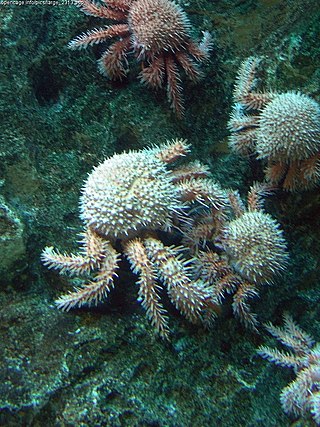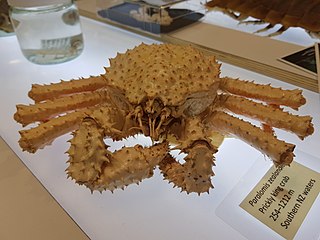
Crabs are decapod crustaceans of the infraorder Brachyura, which typically have a very short projecting "tail" (abdomen), usually hidden entirely under the thorax. They live in all the world's oceans, in freshwater, and on land, are generally covered with a thick exoskeleton, and have a single pair of pincers. They first appeared during the Jurassic Period.

Hermit crabs are anomuran decapod crustaceans of the superfamily Paguroidea that have adapted to occupy empty scavenged mollusc shells to protect their fragile exoskeletons. There are over 800 species of hermit crab, most of which possess an asymmetric abdomen concealed by a snug-fitting shell. Hermit crabs' soft (non-calcified) abdominal exoskeleton means they must occupy shelter produced by other organisms or risk being defenseless.

The Dungeness crab is a species of crab inhabiting eelgrass beds and water bottoms along the west coast of North America. It typically grows to 20 cm (7.9 in) across the carapace and is a popular seafood. Its common name comes from Dungeness Spit, United States, which shelters a shallow bay inhabited by the crabs.

King crabs are a taxon of decapod crustaceans that are chiefly found in cold seas. Because of their large size and the taste of their meat, many species are widely caught and sold as food with the most common being the red king crab.

Paralomis histrix is a species of king crab, family Lithodidae. It lives at a depth of 180–400 m (590–1,310 ft) in Tokyo Bay, Enshunada and through to Kyūshū. It has few predators because of its size and spiky carapace. It is sometimes kept in public aquariums and is occasionally referred to as the porcupine crab, a name otherwise used for Neolithodes grimaldii.
Paralomis africana is a species of king crab found off the coast of Namibia. It has been found from 570–770 metres (1,870–2,530 ft). Its carapace is pentagonal and has been measured to a width of 74.2 millimetres (2.92 in) and a length of 65.8 millimetres (2.59 in).

Paralomis is a genus of king crabs. It includes the following 69 species:

The coconut crab is a terrestrial species of giant hermit crab, and is also known as the robber crab or palm thief. It is the largest terrestrial arthropod known, with a weight of up to 4.1 kg (9 lb). The distance from the tip of one leg to the tip of another can be as wide as 1 m. It is found on islands across the Indian and Pacific Oceans, as far east as the Gambier Islands, Pitcairn Islands and Caroline Island and as far south as Zanzibar. While its range broadly shadows the distribution of the coconut palm, the coconut crab has been extirpated from most areas with a significant human population such as mainland Australia and Madagascar.
P. africana may refer to:

Lithodes is a genus of king crabs. Today there are about 30 recognized species, but others formerly included in this genus have been moved to Neolithodes and Paralomis. They are found in oceans around the world, ranging from shallow to deep waters, but mostly at depths of 100–1,000 m (300–3,300 ft). They are restricted to relatively cold waters, meaning that they only occur at high depths at low latitudes, but some species also shallower at high latitudes. They are medium to large crabs, and some species are or were targeted by fisheries.

Paromola cuvieri is a species of crab in the family Homolidae, the carrier crabs. It occurs in the eastern Atlantic Ocean and the Mediterranean Sea, from Angola to Norway, the Northern Isles and Iceland. It is demersal, occurring at depths of 10–1,212 metres (33–3,976 ft), but it is primarily found deeper than 80 m (260 ft). It prefers areas with mud and emerging rocks, and has been observed in deep-water coral gardens and sponge aggregations. It is locally common.

Paralomis zealandica, also known as the prickly king crab, is a species of king crab which lives at a depth of 254–1,212 m (833–3,976 ft) in New Zealand. It has spiky carapace. The scientific name of the species was first validly published in 1971 by Dawson & Yaldwyn. P. zealandica can be distinguished from other species in New Zealand waters by its thick covering of strong upright spines all over, including on its abdomen and along its legs and claws. The rostrum has three short, strong and sharp spines. It is the most prominent species of Paralomis in New Zealand.

Neolithodes agassizii is a species of king crab native to the Western Atlantic. They live at depths of 200–1,900 metres (660–6,230 ft), and have been found as far south as Rio de Janeiro, as far north as latitude 36°, and near the Equator. It has been found in the southwestern Caribbean Sea as well as the Gulf of Mexico.
Neolithodes yaldwyni is a species of king crab which is found in the Ross Sea from depths of 124–1,950 metres (407–6,398 ft). It had previously been misidentified as Neolithodes brodiei, and it closely resembles Neolithodes capensis.
Neolithodes asperrimus is a species of king crab native to the coast of Africa. It has been found in South Africa and Mauritania at depths of 997–1,862 metres (3,271–6,109 ft), and Neolithodes aff. asperrimus has been found in Madagascar, Réunion, and the South Region of Brazil.
Neolithodes capensis is a species of king crab which is found in the Southern Ocean and the western Indian Ocean. It has been found to a depth of 660–3,200 metres (2,170–10,500 ft).
Paralomis dawsoni is a species of king crab which lives in New Caledonia, New Zealand, and the Solomon Islands at depths of 400–1,118 m (1,312–3,668 ft). It is the largest species of Paralomis in New Zealand.










